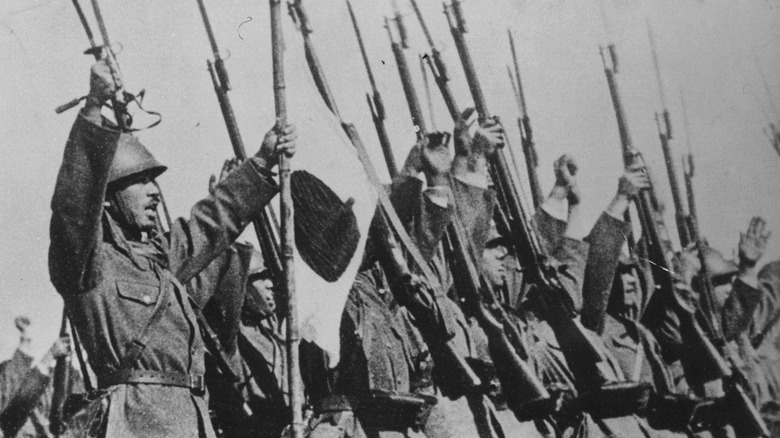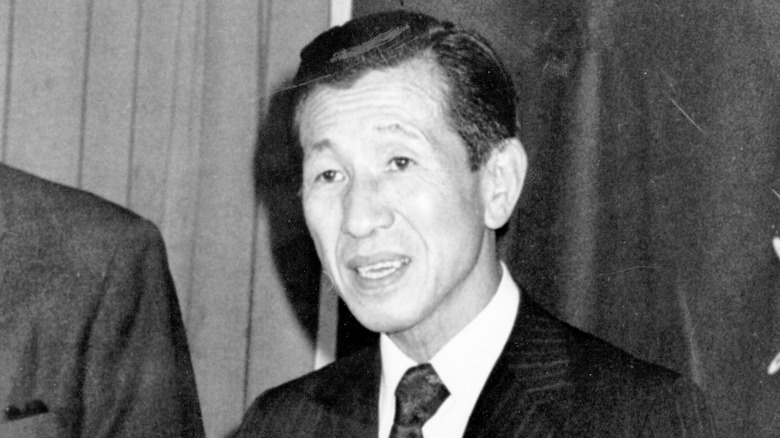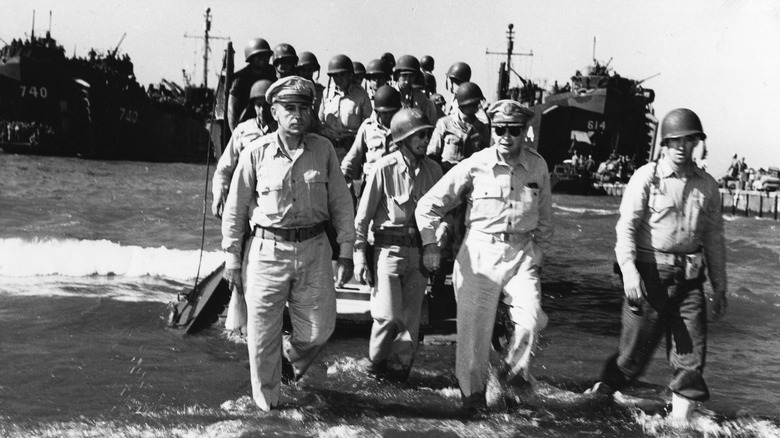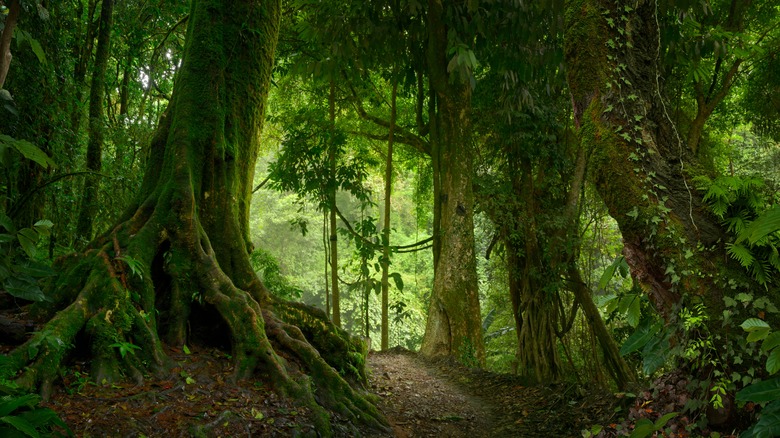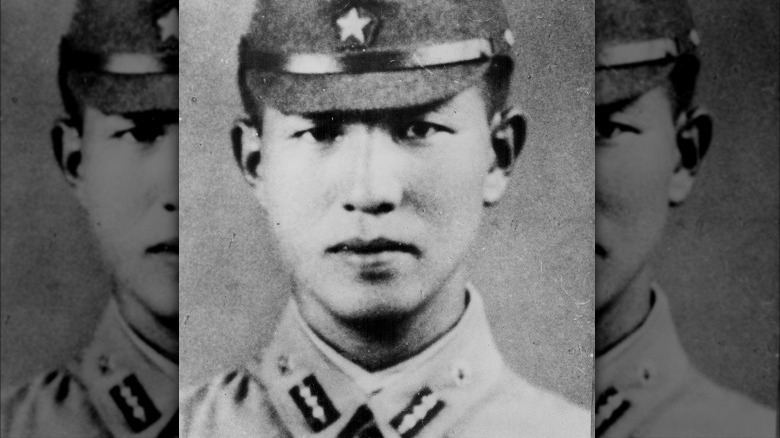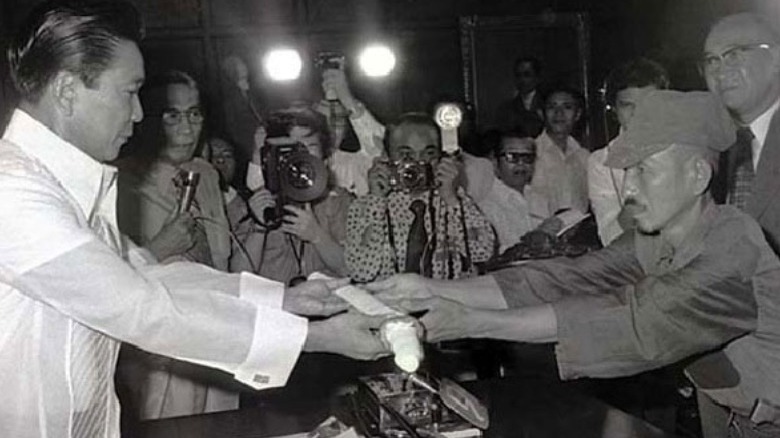The Japanese Soldiers Who Kept Fighting World War II
All nations involved and practically every textbook ever printed can all agree that World War II officially came to an end in 1945 when the Japanese formally surrendered aboard the U.S.S. Missouri (via History). However, a small group of Japanese soldiers continued to fight the war, some well into the 1970s.
The most well-known of these soldiers is Hiroo Onoda, who was finally convinced to surrender after spending three decades on an island in the Philippines where he had previously been joined by three other soldiers. According to The Guardian, Onoda, a soldier highly devoted to the Japanese government who even considered the emperor to be a god, was only convinced to formally surrender when his former commanding officer visited him on the island and assured him that the war was over. While Onoda's story went on to become the most famous instance of a Japanese soldier not officially surrendering, it's just one instance of quite a few that occurred in the years after the Japanese government's official surrender.
Hiroo Onoda during World War II
Hiroo Onoda was born in 1922 and grew up on the Japanese island of Honshu, the biggest of the four main islands that make up Japan (via Britannica). In 1940, Onoda enlisted in the Army and attended the Nakano School, where some of Japan's elite soldiers were trained. There he learned about a slew of disciplines that would help him during — and in his case, also after — the war, including guerrilla warfare tactics, martial arts, and propaganda, per History.
In 1944, it was clear that the war in the Pacific was starting to tilt in favor of Allied forces. Onoda was an intelligence officer at this point and was deployed to the island of Lubang in the Philippines, where his objective was to sabotage airstrips and harbors with the hope of making the imminent United States invasion much more difficult.
The same infrastructure Onoda was sent to sabotage was important for evacuating the island in the event of an invasion. When that invasion finally came in February 1945, the Americans made relatively quick work, killing most of the Japanese forces on the island. Around this time, Onoda received one final order: Do not surrender, no matter what.
Onoda and company
According to Uncharted Philippines, the island of Lubang features beaches, rain forests, and rocky terrain. This backdrop of diverse terrain served as Hiroo Onoda's home for the next 29 years. However, Onoda wasn't alone on the island, and according to History, he was accompanied by three compatriots: Private Yuichi Akatsu, Private First Class Kinshichi Kozuka, and Corporal Shoichi Shimada.
About a month after the Japanese officially surrendered to the United States, word got to Onoda's group on Lubang. The news came courtesy of another group of holdouts on the islands who were in possession of a leaflet that had been airdropped on the island, telling any remaining soldiers that the war was over and instructing them to come out of hiding. Another leaflet was dropped this time with an order to surrender, attributed to a Japanese general, Tomoyuki Yamashita. According to Britannica, Yamashita had been responsible for Japanese attacks on Singapore and Malaysia during the war and was executed in 1946 for war crimes.
Perhaps leaning on his training in propaganda, Onoda didn't buy it and was convinced that the leaflets were American forgeries designed to coerce a surrender. In Onoda's mind, the war was still on.
Life on Lubang
Whether Onoda wanted to believe it or not, World War II really was over, but that didn't mean that his stay on Lubang would be an island retreat. Seeing as he and his fellow soldiers thought they were still at war, they engaged in guerrilla warfare with the residents of the island. This went on for years, and according to History, police on the island launched search parties to track down the soldiers, but to no avail. According to The Guardian, it's believed that Onoda killed as many as 30 villagers on Lubang after mistaking them for opposition forces.
However, by 1949, one of Onoda's fellow soldiers, Private Yuichi Akatsu, started to think that the war may actually be over, and after several months of living away from the group, he surrendered to Filipino authorities. Following his surrender, Akatsu was able to tell the Japanese government that there were still soldiers on Lubang and who they were. The Japanese government collected letters from the soldiers' families and dropped them on the island. Onoda and his fellow soldiers found them, but once again believed it was a propaganda ploy by the United States.
Death on Lubang
After Akatsu's surrender and into the 1950s, Onoda's group was comprised of just himself, Private First Class Kinshichi Kozuka, and Corporal Shoichi Shimada. In 1952, the group raided a fishing village on the island. In the process, Shimada suffered a gunshot wound to the leg. According to History, the group was able to tend to the wound well enough that he survived, but in 1954 he was shot and killed, this time by a search party that was specifically looking for remaining Japanese holdouts.
This left two, Onoda and Kozuka, and they both survived for the next two decades, unaware that the world had moved on to other wars as the Korean and Vietnam Wars raged in the 1950s and '60s, respectively. They survived by building huts out of bamboo and eating whatever they could find, even if they had to steal or kill a farmer's cow (via The New York Times).
In 1972, the two remaining soldiers were trying to break into and steal from a rice silo when they were caught in a shootout with police. Kozuka was killed in the exchange, leaving Onoda alone as the last holdout on the island.
Onoda finally surrenders
According to The New York Times, Onoda had been declared legally dead in 1959. Obviously he was alive and well, but that wasn't confirmed until he was found by a student who was specifically trying to track him down.
Soon after, one of Onoda's commanding officers traveled to Lubang to convince him to surrender. Only then did he finally accept — nearly 30 years later — that the war was officially over. Onoda surrendered to authorities in the Philippines, presenting his sword to Philippines president Ferdinand Marcos (above), who then handed the sword back. Onoda was pardoned for the 30 killings he committed on the island and returned to Japan, albeit a very different Japan than the one he left in the early 1940s. Onoda died at the age of 91 in 2014.
Surprisingly, Onoda wasn't the last Japanese hold-out in hiding. Just a few months after he surrendered an infantryman surrendered in Indonesia — the last confirmed holdout. In 2005, there were unconfirmed reports of two men in their 80s claiming to be Japanese soldiers in hiding. These claims were never substantiated, and Japanese officials were suspicious that the claims were part of an attempted kidnapping plot, as they alleged that the men were in a part of the Philippines known to be frequented by rebel groups (via NBC News).
